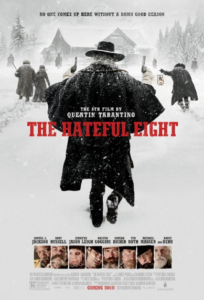
 Quentin Tarantino’s “The Hateful Eight:” An Englishman, a Mexican, a redneck, and a black guy walk into a bar… It’s like a bad racist joke.
Quentin Tarantino’s “The Hateful Eight:” An Englishman, a Mexican, a redneck, and a black guy walk into a bar… It’s like a bad racist joke.
Sure, QT has never been one for political correctness, but “Hateful Eight” is his thumb in the eye of all those who called him out for his often gratuitous use of the N-Word combined with plentiful obvious racial stereotyping. But somehow, sheepishly I say, the movie is undeniably entertaining, if also universally insulting. While the Southerners get the worst end of it in this superbly indulgent piece of 70mm filmmaking, Tarantino has the last laugh as he takes essentially the same tight narrative that minted him with “Reservoir Dogs” in 1992 and reinvents it by setting things in post-Civil War Wyoming.
A blizzard is coming. And bounty-hunter the Hangman John Ruth (Kurt Russell) is hastily making his way to an outpost to find safe shelter while the storm blows over. In his custody is Daisy Domergue (Jennifer Jason Leigh), a ruthless murderer scheduled to be hung in the town of Red Rock. Along their path they run across Major Marquis Warren (Samuel Jackson), another bounty-hunter, who has a big reputation. He’s an escaped slave who fought for the Union, achieving a high rank in the calvary. Reluctantly, Ruth gives Warren a ride aboard his stagecoach. After a bit of banter, they meet another man who then becomes their passenger. The storm is steadily getting worse.
In time, the three men and the murderess will find temporary safe haven at a place called Minnie’s Haberdashery. But what they find there is anything but safety.
Relying heavily on dialogue and performance, the actors are all uniformly good in “Hateful Eight.” There are some surprises as the film advances to the closing act. Tarantino’s muse, Samuel Jackson, is as much a lead as any in this ensemble piece, and he helps make the racially charged language more palatable. There are hints of misogamy present as the murderess, played well by Jennifer Jason Leigh, is bashed about through the bulk of the narrative. Clearly Tarantino wants to leave no single group un-offended.
In 2015, it was good to see Kurt Russell back in widely released films—see, also, his extended cameo in “Furious 7.” He’s right at home in a Western, and this isn’t the only film this year of that genre in which he appears (“Bone Tomahawk” being the other notable entry). And with the soon-to-be-released “The Revenant” we see a definite resurgence of Western era stories on screen. For my money, the best example in 2015 was writer/director John Maclean’s terrific debut “Slow West” starring Michael Fassbender.
It is interesting that all three films employ different camera approaches in capturing the rugged frontier. Tarantino is committed to large format 70mm old school film (shot by multiple Oscar winner Robert Richardson). By contrast “The Revenant” director Alejandro G. Iñárritu utilizes, under the control of cinematographer Emmanuel Lubezki, the Arri Alexa 65 digital camera. And arguably a large step downward (technology-wise) Maclean and his director of photography use the Canon 1DC, which is very much like a giant DSLR that shoots 4K video. All three films look really beautiful, but given the success of those shot on digital, one wonders whether the increased fascination with film will continue.
Reminding us of the set up to another Tarantino written movie, “From Dust ’Til Dawn,” and restricting the bulk of his story to the interior of the haberdashery during a blizzard, “Hateful Eight” builds remarkable tension around a largely talky narrative. The now familiar Tarantino-speak is on full display. But word to the wise: sensitive viewers best stay away.
